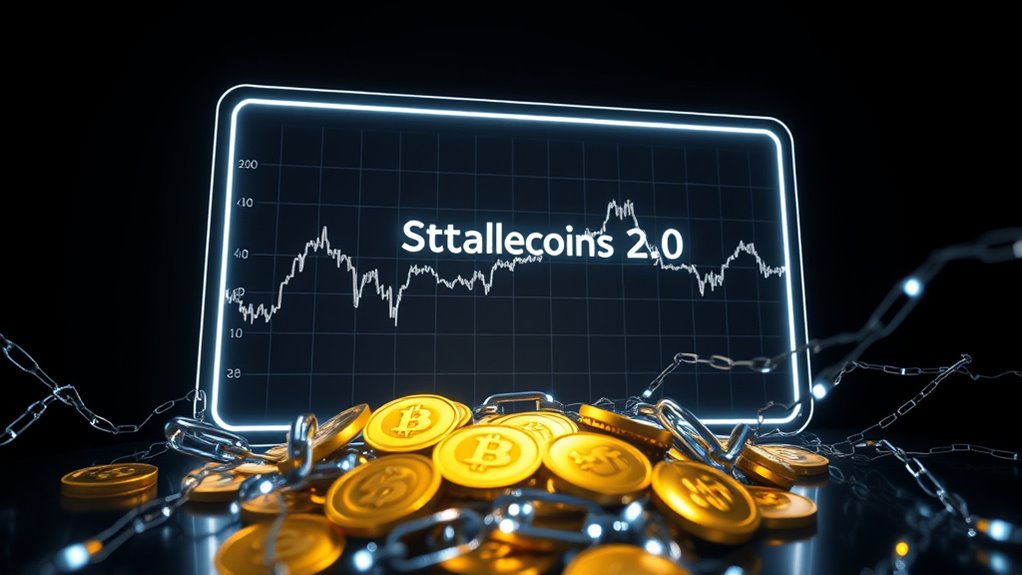Stablecoins 2.0 aim to tame crypto volatility by combining reserve backing with algorithmic mechanisms, offering a more stable and trustworthy asset. Reserve-backed stablecoins provide real assets to maintain their peg, while algorithms adjust supply to smooth out short-term fluctuations. This hybrid approach reduces risks and boosts confidence, making stablecoins more practical for everyday use. If you want to understand how these innovations are reshaping digital finance, there’s more ground to cover below.
Key Takeaways
- Stablecoins 2.0 combine reserve backing with algorithmic mechanisms to enhance stability and transparency.
- They utilize smart contracts to automatically adjust supply and counteract price deviations.
- Hybrid models address the limitations of pure reserve or algorithmic approaches, increasing trustworthiness.
- Improved transparency through rigorous reserve audits and sophisticated algorithms reduces de-pegs.
- These innovations aim to make stablecoins reliable, scalable assets suitable for mainstream financial adoption.

Stablecoins have become a cornerstone of the cryptocurrency ecosystem, but as the market matures, the need for more robust and reliable versions has become clear. In the early days, many stablecoins relied heavily on reserve backing, meaning they held fiat currency or assets in reserve to maintain their peg to a stable value. This approach works well when reserves are transparent and adequately managed, but it can also introduce risks if reserves are mismanaged or not fully transparent.
Stablecoins initially relied on reserve backing but face risks if reserves are mismanaged or lack transparency.
As a result, newer stablecoins are exploring alternative mechanisms to enhance stability and trustworthiness. One significant innovation is the development of algorithmic stability. Instead of relying solely on reserve backing, these stablecoins use algorithms and smart contracts to automatically adjust their supply based on market demand. When the price of the stablecoin drifts away from its peg, the algorithm steps in, either minting new tokens or burning existing ones, to restore equilibrium.
This process mimics the way central banks use monetary policy to control inflation, but it’s executed automatically and transparently on blockchain networks. Algorithmic stability allows for scalability and reduces dependence on physical reserves, which can sometimes be subject to audit issues or reserves depletion.
However, the combination of algorithmic stability and reserve backing isn’t mutually exclusive. Many of the most innovative stablecoins are integrating both approaches to leverage their respective strengths. For example, reserve-backed stablecoins can provide a solid foundation of collateral, ensuring a degree of security in volatile markets. Meanwhile, algorithms can fine-tune the supply, smoothing out short-term fluctuations and maintaining a stable peg more efficiently.
This hybrid approach is designed to address the limitations of each method when used alone, providing users with a more resilient and trustworthy asset. As you explore Stablecoins 2.0, you’ll notice that transparency is a key focus. Projects are investing in better reserve audits and adopting more sophisticated algorithms to manage stability.
These improvements aim to reduce the risk of sudden de-pegs and foster greater confidence among users and institutions alike. The evolution of stablecoins reflects a broader effort to tame crypto volatility, making digital assets more practical for everyday use, from payments to savings.
In essence, the future of stablecoins hinges on blending innovative stability mechanisms with transparent reserve backing. This synergy aims to create assets that aren’t only stable but also trustworthy and scalable. As you follow this space, you’ll see how these advances could finally bring stablecoins from speculative tools or meme assets to reliable financial instruments, ready to serve the mainstream financial system.
Frequently Asked Questions
How Do Stablecoins 2.0 Differ From Traditional Stablecoins?
Stablecoins 2.0 differ from traditional stablecoins by using algorithmic stability mechanisms instead of relying solely on collateral.
You’ll notice they employ complex algorithms to maintain price stability, adjusting supply dynamically. Additionally, they use collateral diversification, spreading assets across multiple types to reduce risk.
This approach helps tame crypto volatility more effectively, making stablecoins 2.0 more resilient and adaptable to market fluctuations than their traditional counterparts.
What Are the Main Risks Associated With Stablecoins 2.0?
Think of stablecoins 2.0 as a ship steering turbulent waters. Your main risks include regulatory uncertainties that could tighten controls and limit growth, like storms threatening the voyage.
Additionally, market adoption remains uncertain; if users don’t trust or embrace these coins, their stability is compromised.
You need to stay vigilant, as shifts in regulation or adoption patterns could dramatically impact their effectiveness and longevity.
How Will Stablecoins 2.0 Impact Global Financial Systems?
You’ll see stablecoins 2.0 potentially reshape global financial systems by influencing monetary policy and challenging currency sovereignty.
They can offer faster, cheaper cross-border transactions, but may also complicate regulation and national control over money supply.
As these stablecoins gain mainstream acceptance, governments might need to adapt policies to balance innovation with financial stability, ensuring they don’t undermine traditional currencies or weaken monetary sovereignty.
Are Stablecoins 2.0 Legally Regulated Worldwide?
You might wonder if stablecoins 2.0 are legally regulated worldwide. While some countries develop clear legal frameworks and enforce regulatory compliance to cover these digital assets, many others lack thorough rules, creating a patchwork of regulations.
This inconsistency affects their widespread adoption and trust. As the landscape evolves, expect more nations to implement laws, balancing innovation with oversight to ensure stability and consumer protection.
What Technological Innovations Power Stablecoins 2.0?
You’ll find that stablecoins 2.0 are powered by innovative technologies like algorithmic stability, which maintains their value through complex algorithms adjusting supply and demand.
Cross-chain interoperability allows these stablecoins to operate seamlessly across different blockchain networks, enhancing their utility and stability.
These advancements help reduce volatility and increase trust, making stablecoins 2.0 more reliable for everyday transactions and broader financial applications.
Conclusion
As you explore the evolving world of stablecoins 2.0, you’ll find they’re quietly working to smooth out the bumps in crypto’s journey. With innovative features and enhanced stability, these digital assets aim to make your experience more predictable and secure. While the path may still have gentle curves, embracing these advancements could gently guide you toward a more balanced and confident crypto future. Stay tuned—you might just uncover the stability you’ve been seeking.










